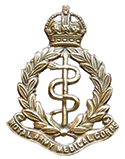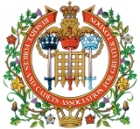
RAMC VOLUNTEERS – A BRIEF HISTORY
Volunteer Infantry Brigade Bearer Companies
In the early 1880s the Army was organised along the lines of Regiments of Foot, Cavalry and Artillery with support from Engineers, Transport, Ordnance and Medical Branches. There was a Standing Regular Army which could be sent anywhere to defend the Crown and this was supported by a Militia, or citizens' army, which could be called out if the homeland was in danger (they could not serve abroad). In addition, there were Yeomanry and Volunteer units.
In the Volunteer Army of Queen Victoria's times there was at first no authorised medical establishment; however, the Volunteer Infantry Brigades raised Bearer Companies in support of the Regiments (VIBBC). The Commanding Officer of a Volunteer Infantry Brigade Bearer Company was a doctor in local practice, the men trained to St John Ambulance Brigade Standards.
Volunteer Medical Staff Corps
In 1883, Mr James Cantlie formed a Volunteer Bearer Company from the medical students at Charing Cross Hospital (where he was Assistant Surgeon) having seen the drill standards of the VIBBCs. It had followed an invitation to give lectures on first aid to a Volunteer Ambulance class in March 1882, where the instructor in stretcher drill was Sergeant Maclure of the London Scottish Volunteers.
This was followed by a second company raised by J E Squires at University College Hospital. Other companies were rapidly raised at The London, St Bartholomew's, The Middlesex, St Thomas's, Guy's and St Mary's Hospitals. By 1884 there were about 300 personnel (in five London Companies) all uniformed at their own expense (the joining fee was 10 shillings with a further annual subscription of 10 shillings) and awaiting Official Recognition. The officers of the ‘Hospital' Volunteer Medical Staff Corps (VMSC) were surgeons and clinicians with the other ranks medical students with the exception of Birkbeck College (the other ranks consisted of ‘lay' people with no medical pre-knowledge).
Further VMSC Companies were raised all over the country with Edinburgh, Glasgow, Woolwich,
Manchester, Maidstone, Leeds, Aberdeen and Norwich following Mr Cantlie's lead. The VMSC was officially recognised in April 1885 when J Cantlie was commissioned as Surgeon Commandant, and JH Casson, WH Platt, WE Raw, JE Squires and EW Willett were commissioned into the new Corps as Surgeons in June 1885.
The VIBBC and the VMSC were completely separate organisations and should not be confused with
each other. The Royal Army Medical Corps was formed in 1898 although it wasn't until 1902 that the VMSC was retitled as the Royal Army Medical Corps (Volunteers).
Authority was granted in 1907 for the raising of 23 General Hospitals that were to consist of a manning cadre of 3 Officers and 4 Other Ranks in peacetime, with local hospital doctors and qualified nurses earmarked to be the staff in the event of War.
In 1915, Clearing Hospitals were authorised at a scale of 1 to a Division. These were cadres with a strength of 1 x Lieutenant Colonel, 1 x Captain, 1 x Quartermaster, 1 x Sergeant, 1 x Corporal and 3 x Private Soldiers.
In 1915, the Clearing Hospitals were re-designated Casualty Clearing Stations.
1ST CITY OF LONDON FIELD AMBULANCE TF
Duke of York's Headquarters
4th (City of London) Volunteer Infantry Bearer Company (officially the Royal Fusiliers Volunteer Bearer Company but also known as the Bovril Bearer Company)
1st / 1st Field Ambulance, 56 Division
2nd / 1st Field Ambulance, 58 Division
1st (Reserve) Field Ambulance
167 (City of London) Field Ambulance
167 Field Ambulance
24 (Eastern) Field Dressing Station
17 (London) General Hospital
217 (Eastern) General Hospital Royal Army Medical Corps (Volunteers)
217 (London) General Hospital Royal Army Medical Corps (Volunteers)
257 (Southern) General Hospital RAMC (Volunteers)
221 (Surrey) Field Ambulance RAMC (Volunteers)
256 (London) Field Hospital (Volunteers)
2ND CITY OF LONDON FIELD AMBULANCE
3RD CITY OF LONDON FIELD AMBULANCE
London Companies Royal Army Medical Corps (Volunteers)
1ST LONDON (CITY OF LONDON) GENERAL HOSPITAL
2ND LONDON (CITY OF LONDON) GENERAL HOSPITAL
2 (London) General Hospital
Renumbered as:
57 (Middlesex) General Hospital Royal Army Medical Corps
161 (East Anglian) Field Ambulance
162 (East Anglian) Field Ambulance
163 (East Anglian) Field Ambulance
10 (London) General Hospital
To become:
257 (Eastern) General Hospital Royal Army Medical Corps (Volunteers)257 (Southern) General Hospital Royal Army Medical Corps (Volunteers)
217 (London) General Hospital Royal Army Medical Corps (Volunteers)
221 (Surrey) Field Ambulance Royal Army Medical Corps (Volunteers)
To become:
256 (London) Field Hospital (Volunteers)256 (City of London) Field Hospital (Volunteers)
1ST LONDON (CITY OF LONDON) SANITARY COMPANY
Notes:
- The original unit was made up of highly skilled professional with civilian occupations involved with or connected to medical and sanitary work.
- From October 1914 the unit became responsible for recruiting and training personnel to serve in all sanitary sections of the RAMC serving at a scale of one section to a Division. Thus the sanitary sections served in all theatres throughout the Great War wherever there was a British Army presence.
- When in theatre all personnel of the sanitary sections wore a yellow armband on their upper left arm to indicate that the soldier was fully trained in matters of war sanitation. The armband was originally devised by the Commanding Officer of the 1st London (City of London) Sanitary Company and approved by the War Office in 1910.
- All personnel of the sanitary sections were Territorial Soldiers.
